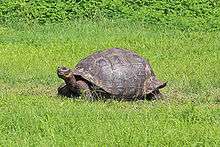Galápagos wildlife
The Galápagos Islands are located off the west coast of South America straddling the equator. The Galápagos are located at the confluence of several currents including the cold Humboldt Current traveling north from South America and the Panama Current traveling south from Central America make the islands cooler than you would think and provide the perfect environment for the unique mix of wildlife that inhabits the islands.
These islands are volcanic in origin and were never attached to any continent. Wildlife arrived here in one of three ways: flying, floating or swimming. Where in most environments larger mammals are normally the predators at the top of the food chain, these animals were unable to survive the journey. Thus the giant Galápagos tortoise became the largest land animal on the islands, and due to the lack of natural predators, the wildlife in the Galápagos is known for being extremely tame without instinctual fear.[1]
The Galápagos Islands are noted as a home to a large number of endemic species. The stark rocky islands (many with few plants) made it necessary for many species need to adapt to survive here and by doing so evolving into new endemic species. It was after visiting the Galápagos and studying the endemic wildlife that inhabit the islands that a young Charles Darwin developed his Theory of Evolution.[2]
Fauna

_-_Galapagos_(2225816313).jpg)
One of the best known is the Galápagos tortoise, which lives on seven of the islands. It has an average lifespan of more than 150 years.
The marine iguana is also extremely unusual, since it is the only iguana adapted to life in the water. Land iguanas, lava lizards, geckos and other harmless snakes can also be found in the islands. The large number and range of birds is also of interest to scientists and tourists. Around 56 varieties live in the archipelago, of which 27 are found only in the Galápagos. Some of these are found only on one island.
The most outstanding are penguins, which live on the colder coasts, Darwin's finches, frigatebirds, albatrosses, gulls, boobies, pelicans and Galápagos hawks, among others. The flightless cormorant, a peculiar bird which has lost the ability to fly, is also part of this rich fauna.
On the other hand, there are many mammal species, mostly sea mammals such as whales, dolphins and sea lions. A few species of endemic Galapagos mice (or rice rats) - the Santiago Galapagos mouse and the Fernandina Galapagos mouse - have been recently rediscovered.
Flora
On the larger [Galápagos Islands], four ecological zones have been defined: coastal, low or dry, transitional and humid. In the first, species such as myrtle, mangrove and saltbush can be found. In the second grow cactus, the incensé tree, carob tree, poison apple tree, chala and yellow cordia, among others. In the transitional zone taller trees, epiphytes and perennial herbs can be seen. The best known varieties are the cat's claw, espuela de gallo. In the humid sector are the cogojo, Galapagos guava, cat's claw, Galapagos coffee, passionflower and some types of moss, ferns and fungus.
References
- ↑ Ricks, Delthia. "Fear Takes a Holiday: Animals of Galapagos Islands Appear to Lack That Instinct". United Press International.
- ↑ "Galapagos Wildlife - Galapagos Islands Animals". 2013-01-21. Retrieved 2016-11-09.
External links
| Wikivoyage has a travel guide for Galapagos wildlife. |
- Birding Site Guide provides birders with free, where to watch birds information worldwide